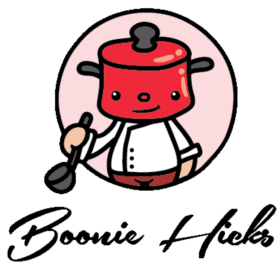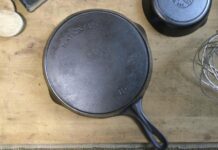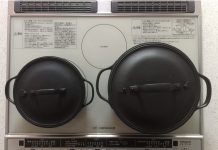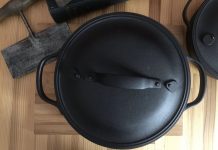Which pot is best for you? The trusty Dutch Oven, or the ever-dependable stockpot? Do they have different uses in the kitchen, or can you use them interchangeably? In this article Dutch Oven versus stockpot. We will discuss the differences between a cast-iron Dutch Oven and a stockpot. So you’ll be able to know which pot is better for your needs.
I’ll also cover the similarities and differences between these two cooking vessels. Including the pros and cons, the best cooking methods for each pot, and the type of food you can cook in them.
With that being said. Let’s get started.
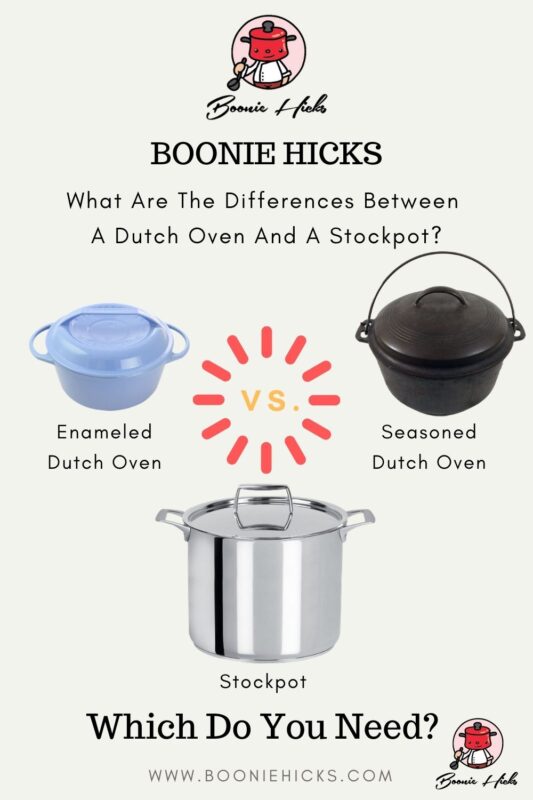
Table of contents
- Differences between Dutch Ovens and stockpots
- Main purposes of the two different pots
- Stockpot design features
- Uses of stockpots
- Benefits of using a stockpot
- Why use should use a Dutch Oven
- Drawback of cast-iron Dutch Ovens
- Why you should you buy a stockpot
- Why you should buy a Dutch Oven
- Final thoughts
Table Stockpots Vs. Dutch Ovens Compared
| Stockpot | Dutch Oven | |
|---|---|---|
Material | Stainless steel, aluminum, or cast aluminum. | Cast iron |
Sizes | Volumes from 4-qt to 24-qt are common for household use. Industrial grade stockpots are available from 8-140 quarts. | 2-6 quart ovens covers the most popular size range. However, smaller and large ovens are available. |
Microwave Safe: | No | No |
Dishwasher Safe: | Yes | Seasoned cast iron: No Enameled cast-iron: Yes |
Table: How stockpots and Dutch Ovens are used in the kitchen
| Stockpot | Dutch Oven | |
|---|---|---|
Main Purpose | To cook a large volume of food in the same pot. | To evenly cook food And to retain natural flavors and tenderness |
Cooking style | Stockpots are ideal for boiling and simmering. | Dutch Ovens are great for roasting, braising, stewing and frying |
Key Benefits | To cook a large amount of food. Ideal pot for canning food such as jams and soups. | Fantastic thermal density distributes heat evenly in an enclosed oven. Great for slow cooking such as pulled pork. |
Negatives | Pots may heat unevenly and cause burning. Large pots are likely to be used less often than a regular size pot. | Dutch Ovens have poor thermal conductivity. Ovens are slow to respond to temperature changes. |
Stockpots: The Big Pot That Helps You Avoid Making a Big Splash in Your Kitchen
Anyone who ever spent time in their grandmother’s kitchen as a kid probably remembers seeing a giant stockpot on the stove that seemed to always be in some state of heating vats of homemade jams and pasta sauce.
In our household, we also used a stockpot to make the Christmas cake mixture. And all the family stirred the cake mixture for good luck.
Stockpots are to cook a large amount of food
Since stockpots have a large capacity, they are ideal for both home and commercial kitchens. And are perfect for bulk cooking and making large portions of soup or stock.
Stockpots are to hold a large amount of liquid without becoming overwhelmingly heavy. After all, the last thing a chef or cook wants is to drop a simmering vat of hot stock.
You can cook large quantities of sauce, soup, and pasta in a single pot. Stockpots tend to be lighter than other cookware. And when comparing a cast-iron Dutch Oven to a similar-sized stockpot, there’s no contest.
Stockpots are designed be easier to lift when fill
While stockpots can appear comically oversized, cookware manufacturers make stockpots to be as lightweight and ergonomically comfortable as possible. To allow you to lift them with ease and to make pouring safer.
A stockpot is ideal if you’re making a mostly liquid batch of food that will require regular stirring. It’s also a must-have item if you often stew fruit or grow vegetables that you need to preserve to prevent waste.
Prevent overflow and splatter using your stockpot
Stockpots are also excellent for recipes that require you to pour in liquid during the cooking process. And during cooking, the large sides walls will also reduce splashes and splatters and bubble-ups.
Do you entertain, have a large family, or enjoy canning? Then a stockpot could be a perfect choice.
Here’s a rundown of some of the best things to cook in a stockpot:
- Broths
- Stocks
- Soups
- Tomato sauce
- Boiling a lot of vegetables such as corn and potatoes
- Boiling whole lobster
- Making jams and chutneys
- Brining
- Making one-pot meals for large families
Benefits to use a stockpot
A good stockpot can perform beautifully at either simmering or boiling. It gives you the freedom to boil water or stock for long periods without concern.
Some stockpots will often feature clear glass and vents that help you see what’s going on in your pot. But larger stock pots will have a no-nonsense metal lid. Metal lids are hard-wearing and will not break or crack.
You’ll notice the handles on a stockpot are small compared to the body. This design is intentional because the idea is that you’ll be tipping to drain or strain what’s in your pot.
Small handles make it easier to grip and safer to lift and tilt your stockpot.
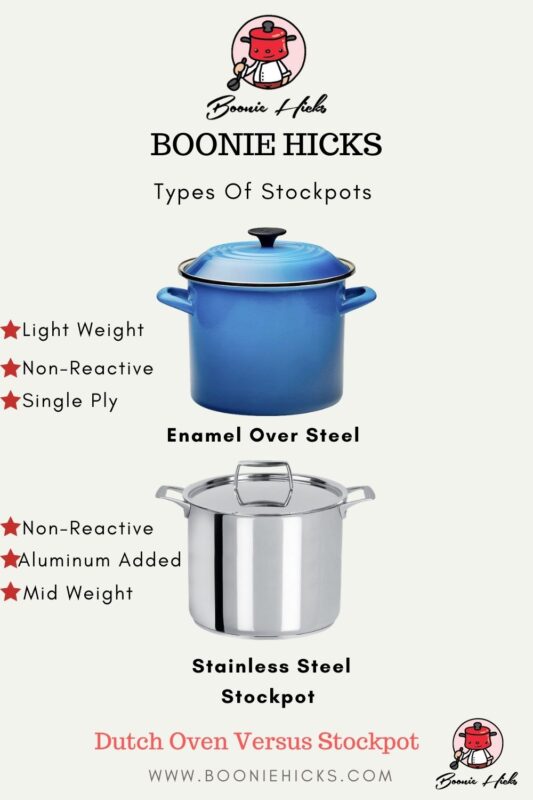
Why would you choose a Dutch Oven instead of a Stockpot?
Dutch ovens are mostly known for being braising tools. That allows you to fry your food before stewing your meal in the pot. Dutch Ovens have a heavy lid and often have basting spikes that retain natural flavors and prevent your food from drying out.
Why you should use a Dutch Oven instead of a stockpot?
However, Dutch ovens are more versatile than many people realize. Another benefit of cooking with a Dutch Oven is that you’re getting an evenly distributed amount of heat on your food.
So a Dutch Oven is perfect if you want to slow cook your meat dishes. And because a Dutch Oven retains moisture and cooks evenly, it’s an ideal pot to bake bread.
Unlike many stockpots, the Dutch Oven offers a two-in-one cooking method because of the way it can go from your stovetop to your oven to put that perfect finishing touch on the recipe you’re bringing to life.
A Dutch oven is superstar for dishes that require browning on the stove to give flavor. And then long, slow cooking in the oven for tenderness.
For you want more reasons to use cast-iron simply click the link.
The biggest disadvantage of a cast-iron Dutch Oven is the weight.
Unfortunately, the thermal density of Dutch Ovens comes at a cost. And that’s the weight.
And is one of the reasons why people avoid cooking “liquid” dishes in Dutch Ovens. If you’re are going to cook large batches of soup, pasta, or stock. A large-capacity Dutch Ovens can become unwieldy. And buying a stockpot would be the better choice.
While you can cook almost anything in a Dutch Oven, trying to lift and tip such a heavy, hot piece of cookware to drain or pour would be both a hassle and hazard.
So here’s a look at some of the best things to cook using a Dutch oven:
- Braised meat
- Stews
- Soups
- Casseroles
- Fried chicken
- Bread
Dutch ovens are perfect for meat dishes because they have even heat distribution that takes away the worries of overcooking and drying out your meals.
Dutch ovens are perfect for family use. And come in a variety of different sizes ranging from below 1 quart to beyond 15 quarts. Learn read about my favorite Dutch Ovens for new users, just click the link for a well researched in-house article.
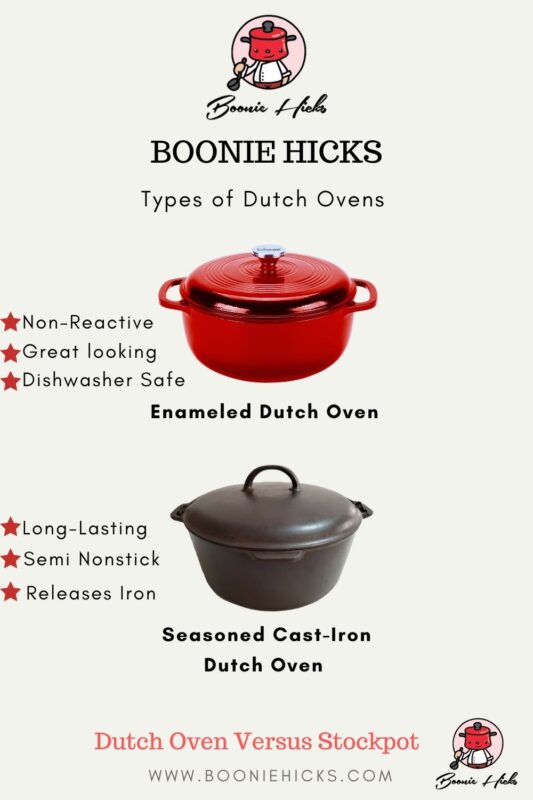
Why You Should Buy a Stockpot?
A stockpot is the better choice if you’re looking for pure volume. A stockpot is a great item to have ready and available if you tend to do a lot of boiling, such as potatoes.
It’s also a good pick for someone who makes big batches of pasta sauce or stock. Cooking that requires easy draining will benefit from a stockpot because it will be lighter to lift than a Dutch Oven of the same capacity.
If you often entertain a group of people, have a large family, or preserve a lot of food, a stockpot will become your new best friend in the kitchen.
Why You Might Buy a Dutch Oven
A Dutch oven is quickly going to become a trusted kitchen companion if you’re looking for a pot that offers tons of variety for different types of dishes that go far beyond boiling and simmering.
With a Dutch Oven, you’re getting the ability to go from burner to oven before placing your pot on the table for serving. Without the need for a different pan or serving dish.
And if you’re into slow cooking, the biasing spikes under the heaving lid will drop moisture back into your food. So the meat will remain tender and juicy.
I prefer traditional seasoned cast iron. But a good option for those new to cast-iron cooking is an enameled Dutch oven. An enameled cast iron doesn’t require seasoning and can be daunting for the new user.
The final thing about Dutch ovens is that many people use the pot as a serving dish. And they look great on the table. And have an old-fashioned homely feel that your guests and family would be sure to love.
Should you choose enameled or seasoned cast-iron? Read on if you want to learn more. You also might want to check out how to select the correct size Dutch Oven.
Final Thoughts on Choosing Between a Stockpot and Dutch Oven
It’s not necessary to pit these two kitchen essentials against each other. In reality, your kitchen is going to benefit from having both. However, the Dutch Oven does provide a little more versatility for whipping up a variety of everyday meals for you and your family.
While Dutch Ovens are much heavier than stockpots, they tend to be much easier to store based on their smaller dimensions.
However, a stockpot is better suited to cook large volumes of fruit and vegetables. So if you have a productive garden and you’d like to preserve your extra food harvest, the stockpot is a perfect choice.
Ultimately if you are preserving or cooking for a large group, choose a stockpot. If you want an everyday pot for you and your family, it’s better to choose a Dutch Oven.
References
- https://gasone.com/blogs/announcements/aluminum-vs-stainless-steel-stock-pots-pros-and-cons
- https://www.homedepot.com/c/ab/best-stock-pots-for-your-kitchen
- https://www.canada.ca/en/conservation-institute/services/conservation-preservation-publications/canadian-conservation-institute-notes/metal-density.html

